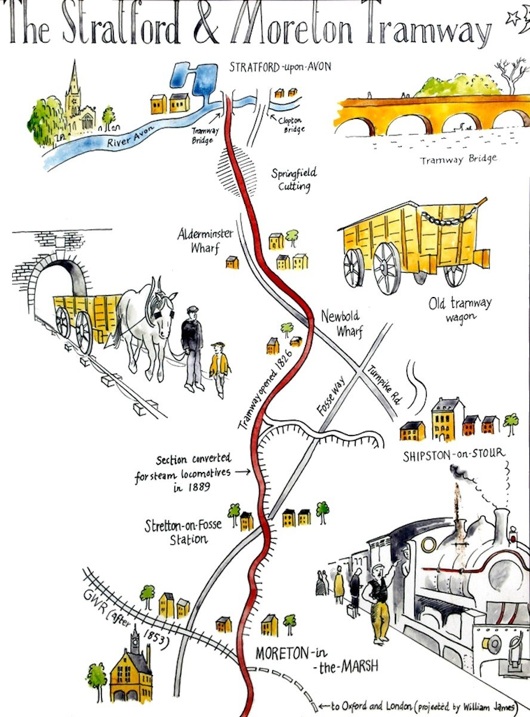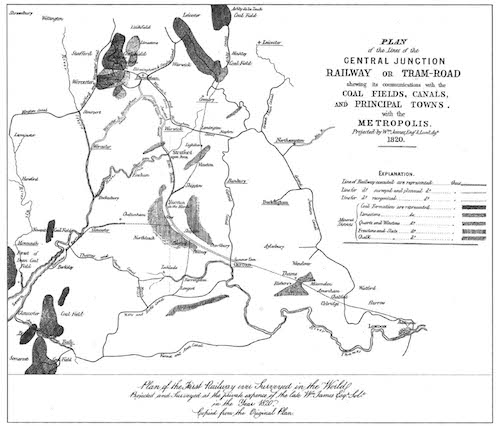Introduction
William James was a lawyer and an extraordinary entrepreneur. Given his success with building coal mines and the Stratford Canal, which he pioneered to bring his coal from Staffordshire further south, he saw that the plateways used at his mines could be extended to provide long distance transport. He discussed the matter with a number of Engineers at the time and started surveying a possible route between Liverpool and Manchester.
Tramway Statistics
Functional Dates:
Extension to Shipston:
Length:
Gauge:
Cost:
Turnover:

SLHS Tramway Construction



Disclaimer
Whilst some care has been taken to check externally linked websites no responsibility is offered nor implied for the suitability, legality or reliability of content therein.
Statements are made here to the best of our knowledge. However no statement here should be regarded as irrefutable fact. Please contact us if you consider otherwise.
Further Information..
-
Brief tramway history: Our Warwickshire
A full treatise on the tramway’s history: Warwickshire Railways-GWR
Walking the current remains: Firkling Blog1992: David & Nigel Shaw: StratfordTramway
Stockton & Darlington Railway is also not preserved: Ollie Webber: Walks What Remains Of The First Steam Passenger Railway YouTube 22m (Oct 2023)
Expert Information..
Explanation of track types: Tring Local History Society: The Permanent Way
History of tram brakes: Tramway Info: Brakes
History of trains running on air: Engadget
Other Engineers
History of IK Brunel: IK Brunel.org
Stratford to Moreton-in-Marsh
Last update: 31/10/2024
● These items have aspects that uniquely contribute to national or world history.
Figuritive map of the line and its stopping points.
(Click for a different map with slightly more details)
Tramway Plan
William James’ Map 1820 (Click for a larger picture)
The original is here: Central Junction Railway
Proceed now to next page: Tramway North
Parl auth: 28 May 1821, opened 1826*. Next UK railway a whole 12y later !
Parl auth: 10 June 1833, opened 1836. Three miles.
16mi (25km)
4’8½“ Stephenson Gauge -as it was always intended to carry steam locomotives
Not yet known.
£28k-32k pa.
*Wharf is William James’ canal speak for tram stop or depot.
Operation
The deal was that the Tramway Company would maintain the track and users would buy a licence to use it. They must provide their own wagons, horses and staff. They must load and unload without inhibiting other users hence the large number of sidings at the Stratford end.
By far the larger amount of business was taking coal south and bringing stone north. However upon paying another £12pa adapted wagons were allowed to carry passengers.
The head was at the Stratford Basins (plenty of pictures here) where his canal met the River Avon.
In the early days producing rails to carry trucks with massive loads of several tons or more, and later even more massive thumping machines, was a very experimental business. Whilst casting iron and machining it for relatively static loads was one thing but sudden load shocks was quite another.
Obviously the first rails were solid cast iron and almost any thickness would eventually crack in these conditions -and if it was cold could crack on its first use. Equally obviously a cracked rail meant derailment, a ruined cargo, a likely dead horse and maybe injured people on, or by the side of, the track. Wrought iron*, whilst more expensive, was more malleable. However even that could fail and so lengths of individual rails were kept sort: 3-4 feet.
Surveying, digging out cuttings and rucking up embankments was time consuming so it’s little wonder that others later tried other methods. For instance all of Brunel’s Broad Gauge track, including his atmospheric railway which avoided the use of any heavy locomotive at all, used longitudinal sleepers and was of a “bridge cross-section”. This was very efficient to lay.
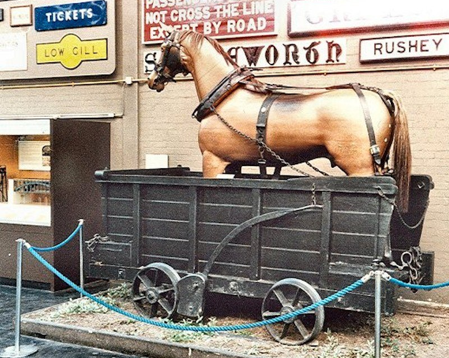
Dandy Wagons Of course the mines used horses to move their wagons and so too did William. Mines were dug generally level but once William’s horses had pulled their wagon up the local hills they could enjoy a free ride home on the back of a Dandy Wagon (like the one above left).
Trucks Example trucks can be seen on the next page.
Passenger Wagons It is not known when the first passenger wagons were used at Stratford but they must have resembled typical hay wagons of the day (like above right). People would climb in from the rear, pay their fare and settle on a trestle. They would not be covered at that time.
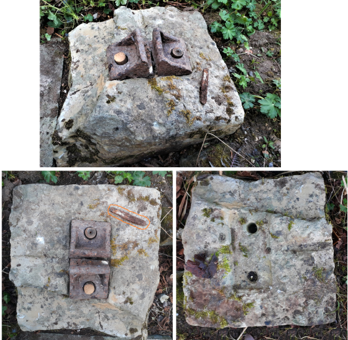
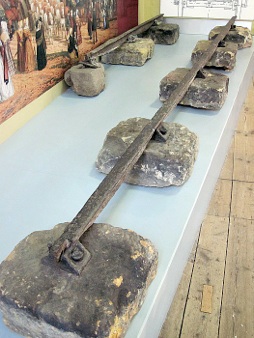
William’s tramway required 66,000 blocks with 132,000 holes drilled in them. Into those wooden plugs were placed and nails driven into them. Of course 66,000 rail chairs were then attached. The rails literally sat on the chairs with wooden wedges driven in horizontally to hold them in place. These allowed some movement but I have no idea how they coped with significant expansion in summer heat (one mile of track could expand by approximately 1 foot). The picture above centre shows how vast numbers of similar stones were set in the earth to spread the load and provide stability to the track. Owning a canal had another advantage -William could bring all this vast tonnage of materials to Stratford at cost. Other railway builders didn’t have this.
(For a really thorough explanation of old types of tracks see Tring LHS in the Further Information section below).
Over the decades track everywhere had to improve. Steel had been invented this was ductile and thus instead of being cast track could be drawn, through a die, in long lengths. In 1863 all the track to Stratford and Shipston was replaced. Sleepers and bladed points were used and modern rolling stock run on it (although by law this still had to be drawn by horses). The old track was melted down and wagons auctioned off. Nearly all decayed and were broken down for scrap. Just two are known to have survived and been refurbished (see next page).
Railway Track Stones
Stockton & Darlington Railway Museum
Original Stratford Tramway Track Stones
DShaw 1992
A Dandy Wagon 1986 National Railway Museum

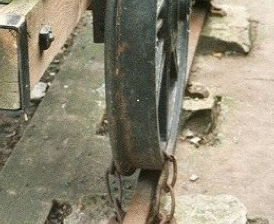
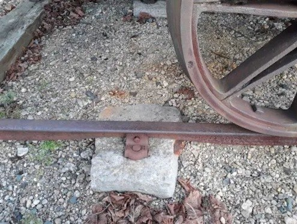
Stratford’s Fishbelly Track DShaw
Stratford’s Wheel Flanges Are Amazingly Modern DShaw
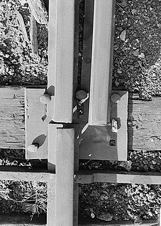
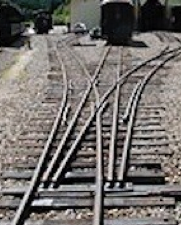
Wise Wheel Profile
On a railway a flange is needed to keep the wheel on the track. This flange can be on the track and so the wheels will be flat bottomed and can be pushed on the ground and even spun on their axis which is an advantage in the confines of a mine. Old plateways were this way too. However this is wasteful on long runs of track thus William opted to put the flanges on his wheels. This had a massive advantage at rail junctions (see next box).
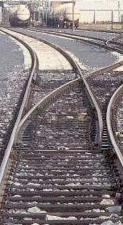
Tramway Junctions
In order to send a train left or right the leading rail is slid left or right (above left) and Stratford probably had these. It is possible to make them three way (above centre). However any misalignment will result in a slight wiggle of the rolling stock. At low speed this is acceptable but these days, at speed, very smooth blades must be used (above right). Notice that the inner outgoing lines are moved. Turntables were also used at terminus Basins
Two-way Stub
Three-way Stub
Modern Blade

Forward Thinking Use Of Standard Gauge
William was wise. He did not want to spend twice. He’d worked with George Stephenson and knew him to be somewhat intransigent. George’s empire up North may one day be big and one day William’s empire to the south would need to connect to it and so he chose precisely the same 4’8½” gauge. Maintaining this width is tricky without any sleepers but he got away with it.
Note that the rather confident Engineer Brunel stepped in later with the huge 7’ gauge. Many years later he was forced to replace it with what became this Stephenson’s Standard Gauge.
Actual track remain on a bridge after closure.
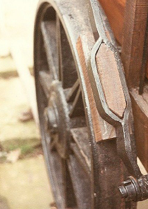
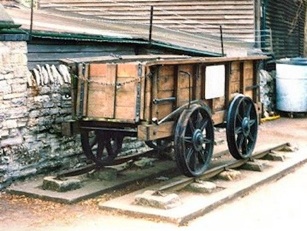
Track but no sleepers.

Necessity Of Brakes In All Conditions
Stratford wagon brake.
Spencer tram brake.
If you have as much as 25 tons of goods, or even precious passengers, at the top of a hill you probably dont want to spin off and William’s tramway snaked its way around a lot. The track gauge and alignment weren’t perfect either. Thus brakes were a necessity. At first simple wooden blocks were used (above left). However in wet weather they had to be lined with leather. Stocks of leather pouches were carried.
The problem of heat and wear is significant and so in 1889 Christopher Spencer, of Halifax, invented the slipper brake that rubbed on the rails (above right). It’s unknown whether these were used on this tramway.
Rolling Stock
Passenger Haulage This example from Isle Of Man
Track
*Iron with very low carbon content is not brittle.
Tramway Implementation
This page is divided into two sections: Tramway Plan and Tramway Implementation For ease of reading the latter is subdivided in coloured boxes.
*Stockton to Darlington Rly parl auth: 19 April 1821, opened 27 Sept 1825.
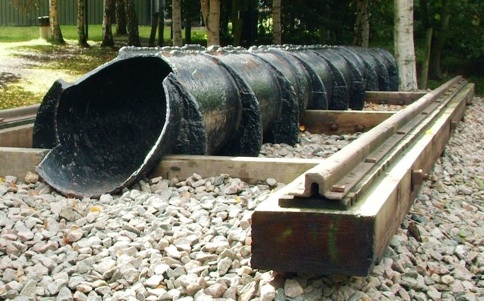
Atmospheric Railway from Exeter to Newton Abbott 1846. Note that no points were possible.
Construction
However he had a more local need and in 1821 he commissioned the great John Urpeth Rastrick (a close colleague of Trevithick and later to be one of 3 judges at the Rainhill Locomotive Trials eight years later in 1829) to build him a standard gauge tramway from Stratford to Moreton-in-Marsh. At that time the act of parliament only allowed for horse drawn vehicles and it opened in 1826 carrying limestone north and his coal south along the route. The opening was celebrated by 20,000 people in Moreton alone (see Opening Day).
Sadly whilst being built he overstretched himself, was declared bankrupt and imprisoned for 2 years. Whilst in King's Bench Prison (Southwark) he planned the tramway’s unrolling down to Oxford then London. He named it the Central Junction Railway.
To the right is a map as was built. Below that is William’s grand plan.
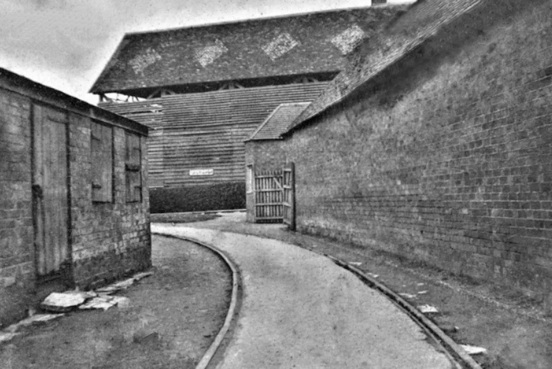
The tramway as it starts to turn arriving into Moreton

To return to Master page click on ‘Tramway’ above.
-
● Full
-
● Partial
-
● None
-
Theatres ●

